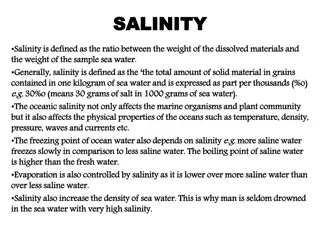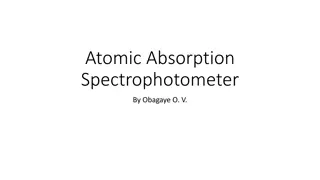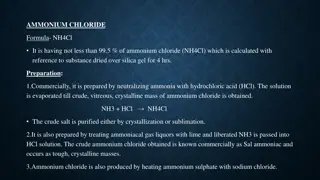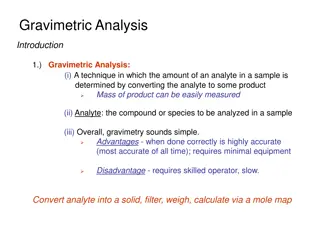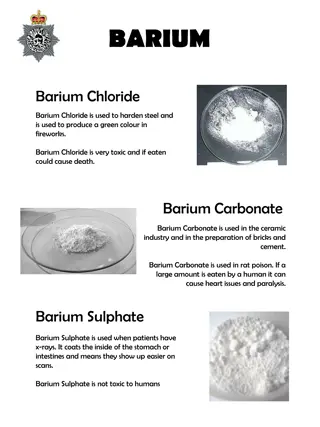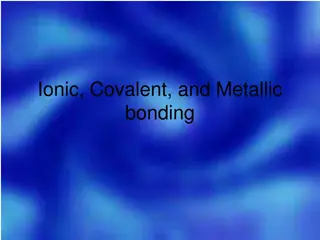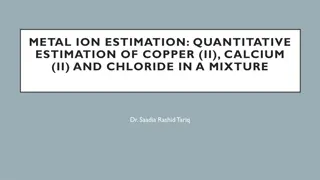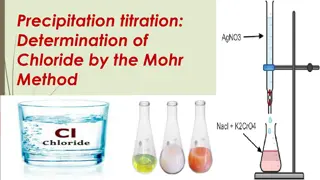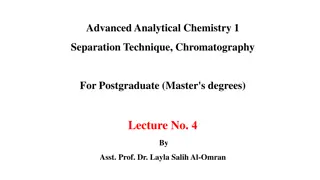Gravimetric Determination of Chloride in Analytical Chemistry
Gravimetric determination of chloride involves precipitating silver chloride from a soluble sample, filtering, drying, and weighing the precipitate to calculate chloride content. Reagents include concentrated HNO3, AgNO3, and NH3, and the procedure consists of steps such as washing, precipitation, filtration, and calculation. The process ensures accurate measurement of chloride levels in a sample.
Uploaded on Sep 07, 2024 | 3 Views
Download Presentation

Please find below an Image/Link to download the presentation.
The content on the website is provided AS IS for your information and personal use only. It may not be sold, licensed, or shared on other websites without obtaining consent from the author.If you encounter any issues during the download, it is possible that the publisher has removed the file from their server.
You are allowed to download the files provided on this website for personal or commercial use, subject to the condition that they are used lawfully. All files are the property of their respective owners.
The content on the website is provided AS IS for your information and personal use only. It may not be sold, licensed, or shared on other websites without obtaining consent from the author.
E N D
Presentation Transcript
Gravimetric Determination of Chloride Gravimetric Determination of Chloride Principle: -The chloride content of a soluble sample is determined by precipitating silver chloride (AgCL) with added silver nitrate (AgNO3) , filtering, drying and weighing the precipitate. -The chloride content is calculated from the weight of AgCL. Ag+ + CL AgCL
Reagent: 1)concentrated HNO3 (Nitric Acid) Concentrated NH3 (Ammonia) Diluted HCL 3M 2)AgNO3 0.1M (Do not get AgNO3 on your hands, if you do wash immediately with a sodium thiosulfate solution. If left on the skin, brown-black spots (metallic silver) will appear within several hours and will take two to three weeks to wear off).
3)wash solution: Add 2 ml of chloride free concentrated HNO3 to about 600 ml of distal water. ( 3.33 ml of HNO3 1 L distal water ) Procedure: We will use beaker with glass rod. 1)Add 0.1 g chloride salt (NaCL). 2)Add 150 ml distal water. 3)dissolve by stirring with rod (do not remove the rod).
4)Add 0.5 ml HNO3 (use burret under hood). 5)Add 0.1 N AgNO3 slowly with constant stirring. You will notice the formation of white precipitate, keep adding AgNO3 until no further precipitate obtained or the solution will appear white in color. 6)Heat nearly to boiling, while stirring constantly until the precipitate coagulate and the supernatant liquid looks clear.
*To make sure that precipitate is complete: By adding drop of AgNO3 to supernatant. If it's turbid, repeat the above step (add more AgNO3). If it's clear, put the beaker after cooling covered by paraffin in a dark place for the next lab.
7)Filtration: After the precipitate has formed and been allowed to digest, the solution is carefully filtered by Filter Paper (the filter is chosen to trap the precipitate). Weigh the filter paper alone then weigh it with the precipitate. To wash off the beaker used the washing solution (cold diluted HNO3)
Calculation: Ag+ + CL AgCL 1 mole CL 1 mole AgCL CL (analyte ) , AgCL (precipitate) *Since : wt CL / wt AgCL = at.wt CL / m.wt AgCL so, wt CL = (at.wt CL / m.wt AgCL) x wt AgCL
*Since: at.wt CL / m.wt AgCL= Gravimetric Factor of CL There fore wt. CL = G.F X wt. AgCL *G.F = 35.45/143.32 = 0.247 Wt. AgCL(wt. of precipitate) = wt.(filter paper+ppt.) wt.(filter paper)
Gravimetric Analysis It is accurate and precise methods of macro quantitative analysis. The analyte is converted to an insoluble form by precipitation with an appropriate reagent. The precipitate collected by filtration, washed, dried and weighed. From the weight of the precipitate and the knowledge of it's chemical composition the weight of the analyte is calculated.
Steps of Gravimetric Analysis: 1-preparation of the solution. 2-precipitation. 3-digestion (heating). 4-filtration. 5-washing. 6-drying. 7-weighing. 8-calculation.
Favorable Conditions for Precipitation: 1-precipitate from dilute solution (this keep concentration low). 2-addition of the precipitating agents should be slowly with effective stirring (this keep concentration low). 3-precipitate from hot solution (this increase solubility). 4-precipitate at low PH (many precipitate are more soluble in acid medium).





